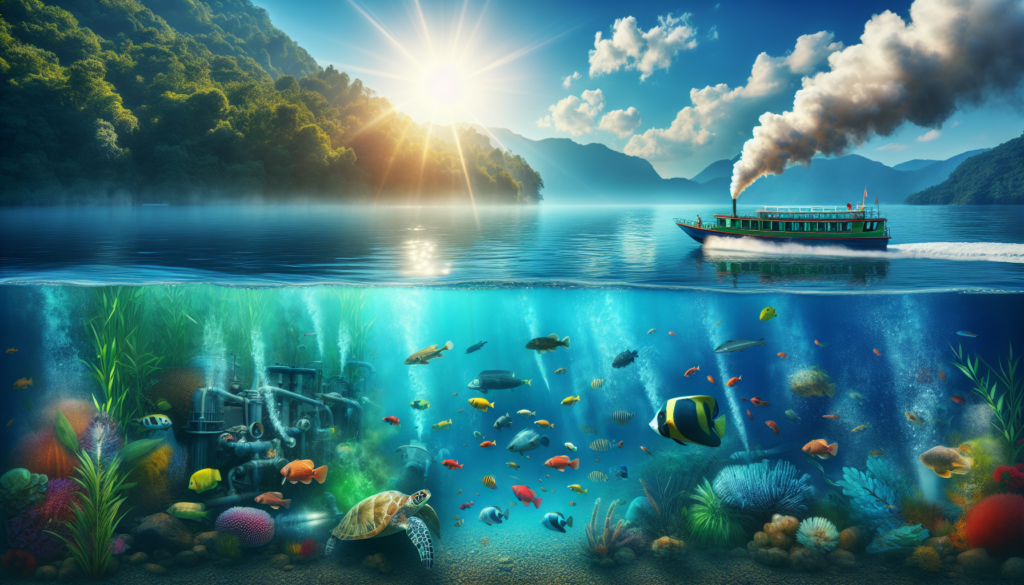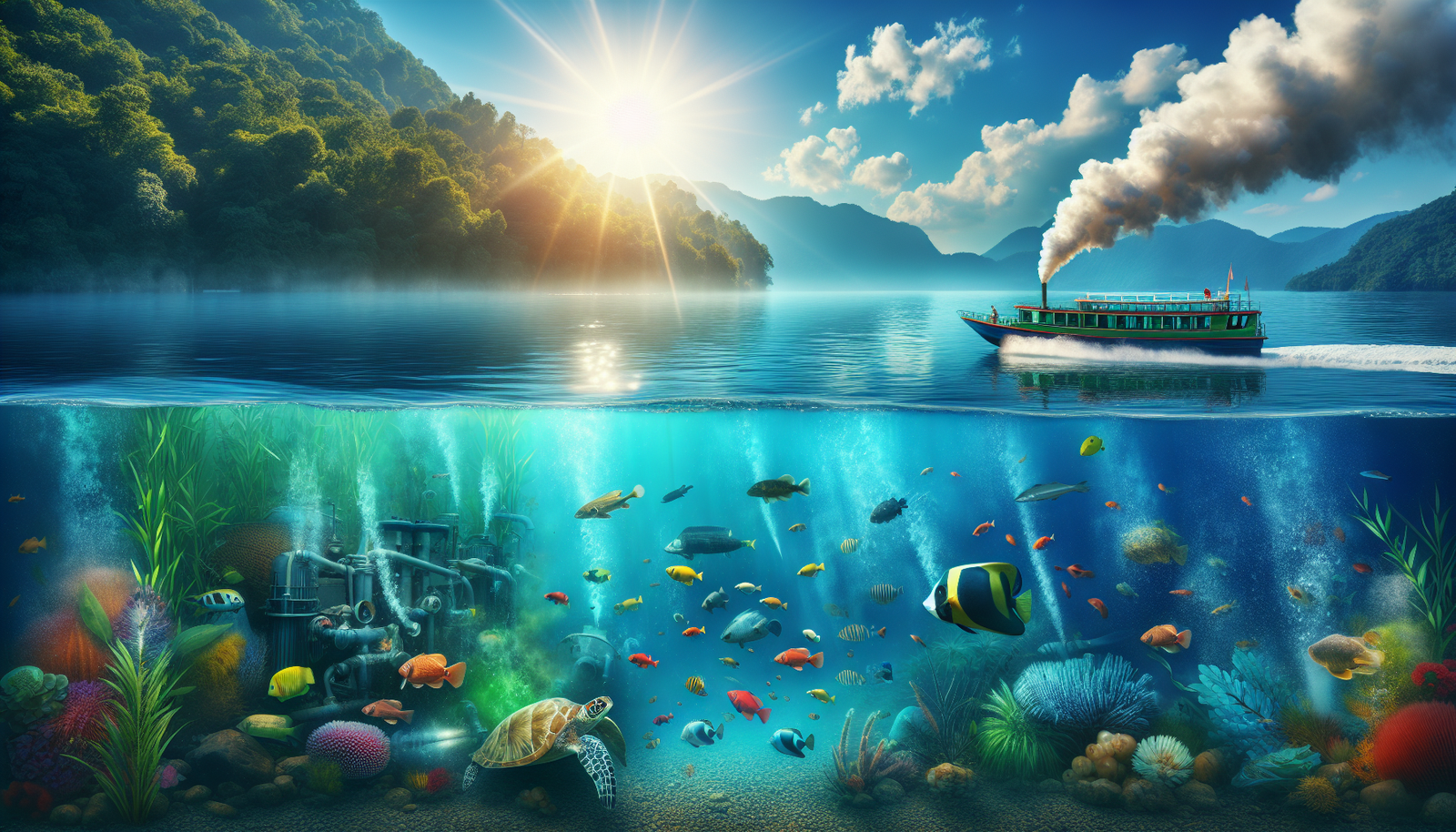Imagine spending a perfect sunny day out on the water. The glinting sun, the gently lapping waves— it’s a vision of tranquility. However, beneath that serene surface, there’s an unseen mess being caused. Strangely enough, it comes from your own boat. The effects of boat engine discharge on aquatic life is an eye-opening topic that unpacks the unseen ecological damage caused by numerous boating activities. Your leisurely cruise across the lake may be disrupting a complex underwater ecosystem more than you know. Now, let’s explore the environmental implications, the seldom-discussed dark side of a seemingly harmless journey across the water.

Understanding Boat Engine Discharge
Ya know, when you’re out on the water in your boat, you might not be thinking about what’s happening underneath you. But you should. One of the byproducts of running a boat engine is something we call “engine discharge.”
Explanation of Boat Engine Discharge
So what exactly is “boat engine discharge?” Relatively straightforward, it’s the gases and particles that are expelled from a boat’s engine during operation. Think about how your car’s exhaust system works — it’s a similar situation. These discharges can consist of various types of pollutants, including oil, grease, fuel, coolants, and other harsh chemicals.
Main Components of Boat Engine Discharge
The main baddies here are hydrocarbons, whom you may remember from your high school chemistry class, and other harmful compounds like nitrogen oxides and sulfur oxides. Tiny particles of oil, fuel, and exhaust residue can also be present. These pollutants are a real big problem for our buddies living in water bodies.
How Boat Engine Discharge Enters Water Bodies
Direct Discharge Into Water Bodies
The most straightforward way engine discharge gets into water bodies is by direct release. When you’re running your boat, the engine generates all that nasty discharge we just talked about. Since there’s usually no exhaust system to filter them out or redirect them, those pollutants go straight into the water.
Indirect Discharge Through Rain Water Runoff
Even when you’re not on the boat, engine discharge can still harm water bodies. Pollutants from an engine can accumulate on the boat’s surface and get carried away by rainwater runoff, which ultimately flows into nearby water bodies. So don’t think you’re off the hook if your boat’s sitting idle in the marina.
Physicochemical Properties of Boat Engine Discharge
Chemical Composition of Boat Engine Discharge
Boat engine discharge is primarily made up of all the harmful chemical pollutants we listed earlier, but in terms of the nitty-gritty specifics, it varies from boat to boat. It all depends on the type of fuel being used, the boat’s engine model, and even how well-maintained the engine is.
Physical Properties of Boat Engine Discharge
Physically, the discharge can be in the form of gases, liquids, or particulates. The tiniest particles can get dissolved in the water, while others can cling to the surface creating an unsightly oily sheen.

Threats of Boat Engine Discharge to Aquatic Life
Effects on Aquatic Plants
These pollutants can seriously mess up plant life in the water. They block sunlight and reduce the oxygen content of the water, disrupting photosynthesis and the overall growth of plants. Over time, this can lead to the death of aquatic plants and a breakdown of the entire food chain.
Effects on Aquatic Animals
Fish and other aquatic critters aren’t safe either. The toxic compounds in the discharge can harm their respiratory systems, cause direct damage to their tissues and organs, and even be fatal.
Long-Term Effects on Aquatic Ecosystems
Over time, continuous boat engine discharge can ruin entire ecosystems. As plant life dwindles and animal populations suffer, the entire food chain can be disrupted, leading to significant biodiversity loss.
Case Study: Impact on Fish Populations
Changes in Fish Behavior
Boat engine discharge doesn’t just harm fish physically; it also messes with their behavior. Fish exposed to these pollutants often display changes in their feeding and mating behaviors, which can throw off natural fish population dynamics.
Impacts on Fish Reproduction
Speaking of fish population dynamics, these pollutants can also interfere with fish reproduction. By affecting their fertility and hatching success, boat engine discharge can lead to declining fish populations over time.
Shift in Fish Population Dynamics
Boat engine discharge can cause shifts in fish population dynamics by favoring harder, pollution-tolerant species over the sensitive ones. This can lead to an imbalance in the ecosystem and makes it hard for the sensitive species to bounce back even if the water’s condition improve.
Case Study: Impact on Coral Reefs
Damage to Coral Structures
Engine discharge can also harm beautiful coral reefs. Tiny particles in the discharge can get deposited on coral structures and hinder their growth, resulting in weak, brittle corals.
Impacts on Coral Reproduction and Growth
Just like with fish, polluted waters can negatively impact coral reproduction and growth. This not only leads to fewer corals but also to the loss of the vibrant, diverse marine life that depends on the reefs for survival.
Shifts in Coral Ecosystems
Over time, the influence of pollutants from boat engines can cause significant shifts in coral ecosystem dynamics. Decreased coral populations can lead to decreased biodiversity and changes to the overall functioning of the ecosystem.
The Role of Laws and Regulations on Boat Engine Discharge
Current Laws and Regulations
Various laws and regulations are in place to control boat engine discharge. These can involve limits on emission levels, compulsory use of exhaust treatment systems, and rules on where and when boats can operate.
Effectiveness of Existing Regulations
However, the success of these regulations is up in the air. Often, enforcement is difficult, and compliance can be low. Plus, there’s not much to stop pollutants from international waters from making their way into more regulated areas.
Potential for New Regulations
It’s clear that more work needs to be done in this area. More stringent regulations, better enforcement, and increased awareness among boaters could all be possible steps towards fixing this problem.
Preventive Measures and Their Effectiveness
Technologies to Reduce Boat Engine Discharge
Luckily, various technologies are available to help reduce engine discharge. Examples include exhaust treatment systems and technologies for capturing and recycling waste products.
Alternative Fuels for Boats
Alternative fuels, like biodiesel or hydrogen, could also help reduce the harmful emissions from boat engines. These fuels burn cleaner and produce fewer harmful pollutants.
Best Practices for Boat Maintenance and Operation
Following best practices in boat maintenance and operation can also significantly reduce engine discharge. Things like regular engine checks, using the right fuel and oils, and avoiding unnecessary idling all make a big difference.
Socio-economic Impact of Boat Engine Discharge on Aquatic Life
Impacts on Fisheries
Boat engine discharge isn’t just bad for the environment; it’s also bad for the economy. It harms fisheries by depleting fish stocks and reducing catches.
Impacts on Tourism Industry
Similarly, the tourism industry could experience a serious hit. Clear, clean water is a big draw for tourists, and damage to vibrant ecosystems like coral reefs could keep visitors away.
Costs of Mitigating Effects of Boat Engine Discharge
The costs of mitigating the effects of boat engine discharge can be substantial. This includes the costs of clean-up operations, implementing control measures, and enforcing regulations.
Future Predictions and Research Needs
Predicted Trends in Effects of Boat Engine Discharge on Aquatic Life
As boating activities continue to increase, we’re likely to see more severe impacts on aquatic life. However, if preventive measures are put in place and followed, there’s chance to change the course.
Areas for Future Research
More research is needed in several areas — from the specific impacts of different pollutants, to the effectiveness of control measures, to the broader socio-economic effects.
The Need for Interdisciplinary Approach
Moving forward, we’re going to need an interdisciplinary approach to tackle this problem. Scientists, policymakers, industry experts, and boaters alike all need to work together. Only then can we hope to protect our beautiful water bodies from the effects of boat engine discharge. So let’s all get on the same boat, shall we?


[…] Another aspect is waste management. Many boats are not equipped with appropriate waste storage and disposal systems. As a result, waste ends up being dumped directly into the sea, causing pollution and harm to aquatic life. […]